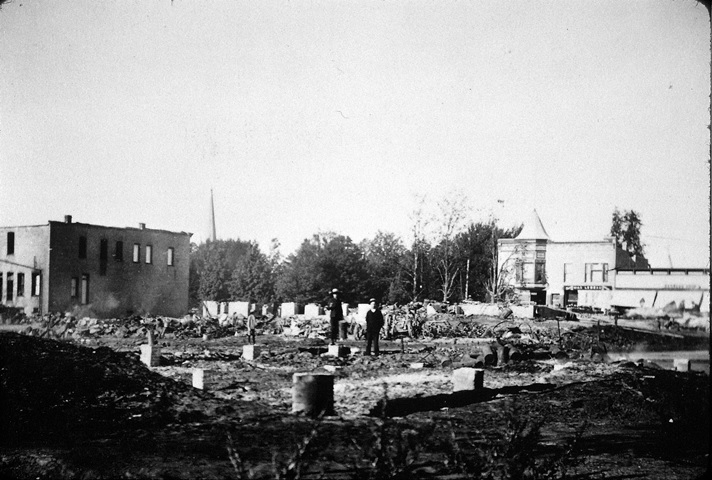Most people have heard of the Great Chicago Fire of 1871, but the Great Libertyville Fire of 1895 may not be as familiar. Nearly 125 years ago, a fire raged through central Libertyville destroying an entire business block in a single night.
In the hours between August 30 and 31, 1895, cigar maker Max LeBeau was awakened by the growl of his dog. His wife thought there might be a prowler. Instead Max discovered huge flames leaping skyward across the street behind the Schanck Hardware store on the northeast corner of Sprague Street [Cook Avenue] and Milwaukee Avenue. The call of “Fire! Fire!” went out.

There was no fire department, so bucket brigades quickly formed and all hands were needed. The Lake County Independent reported: “Many ladies carried water and worked like horses while a few men hung idly on the fence at a safe distance…We need not mention their names as they were marked and their lack of sympathy publicly noted. They will be remembered.”3 The work was hampered by the lack of readily available water, since there was not a public well. A telegram was sent to Waukegan requesting aid, but was later withdrawn when it was realized that help would not arrive in time.
While the bucket brigade was hard at work, other residents rushed to save their business goods and personal possessions. “Furniture was piled along the street in inextricate confusion….The handsome lawn of the Hon. A.B. Cook was piled with wreckage, valuable and worthless mixed, in a confusion seemingly impossible to untangle…Stoves were hurled from second story windows…”6
The efforts of the brigade stopped the spread of the fire eastward and to the south. To halt the spread northward, two buildings were dynamited. The Methodist Church, the next building north, was saved, although all of the windows shattered from the explosion. Nearly all of the windows in the buildings on the west side of Milwaukee Avenue were also broken either from the explosion or the intense heat. It was posited that had it not been for recent heavy rains and the lack of a strong wind, all the town would have been “hardly more than a remembrance – a mass of blackened, smoldering embers.”6
The specific cause was not determined, but there was no mention of a cow kicking over a lantern.

Lake County Independent, September 6, 1895
Some of the earliest structures built in Libertyville were felled by the fire including the three-story Commercial Hotel (previously known as the Grove House, Fisher House, and the Spoor Hotel), the Davis Steele store (1845), and the Sprague general store (1842).
Many businesses suffered substantial financial losses. The lack of fire protection in town had pushed insurance costs so high that building owners chose to hold little or no insurance. G.H. Schanck of the Schanck Hardware store was hit the hardest with a $30,000 loss of which only $2000 was covered. In 2019 dollars that would equate to a loss of over $900,000 with only $61,000 insured.



The 1895 fire caused much destruction and loss, but Libertyville was not defeated. The Lake County Independent newspaper office, located over the Schanck Hardware store, perished in the fire, but printed a paper the following week with a headline in eleven different fonts which read:

Libertyville citizens got to work. Only two days after the fire, the village board passed a law requiring that new buildings be made of brick. Another law set safety requirements for chimneys and other fire prevention measures. In November, 52 residents appeared before the village board to demand better fire protection. Soon a volunteer fire brigade was organized and a manually operated fire engine was purchased.
Libertyville soon rose from the ashes. Commercial development within the village expanded rapidly at the end of the 19th and beginning of the 20th century. In a 1903 special edition of the Lake County Independent dedicated to the growth of Libertyville, one article said “Libertyville’s remarkable growth within the last few years is mainly the result of the great fire of 1895, which wiped out the entire business section. Since then the grit and energy of its businessmen have materialized into what might be termed a united effort to build a new and ideal city on the ashes of the old town.”8
From 1900 to 1910, eleven buildings were constructed within the central business district—nine along Milwaukee Avenue and two on Cook Avenue. The most important commercial building erected during the first decade of the twentieth century was the Proctor Building, financed by Proctor brothers, Robert, Charles, and Richard, with their cousin Elisha. Designed by Chicago architect William Krieg, the two-story brick building housed commercial storefronts and the New Castle Hotel, the largest of three operating hotels in Libertyville at the time. When it was completed in 1903, the block was lauded as “Libertyville’s first metropolitan building, the pride of all citizens…Towns five times the size of Libertyville cannot boast of buildings similar to the Proctor Block – and it can be said that such a building as the Proctor Block is just the kind of building Libertyville requires.”13

While the town suffered a devastating loss at the time, the Great Libertyville Fire of 1895 brought the citizens together and cleared the way for building the downtown Libertyville we recognize today.
Sources
- “Destructive Fire at Libertyville: Dynamite is Used to Destroy Buildings and End the Flames.” Chicago Daily Tribune, 01 Sep 1895: 2
- “Fire Edition.” Reprint of article from Lake County Independent, September 6, 1895 in the Independent Register, October 1979.
- “Burnt but Booming!” Lake County Independent, September 6, 1895.
- “Laid in Ashes.” Waukegan Weekly Gazette, September 7, 1895. p1.
- Libertyville Illustrated. Chicago : Kehm, Fietsch & Miller Co. Press, 1897.
- “All is in Ruin.” Publication unknown. August 31, 1895.
- “Proctor Building.” Lake County Independent, September 25, 1903.
- “Rapid Growth.” Lake County Independent, September 25, 1903.
Categories: Local History
Tags: Local History
